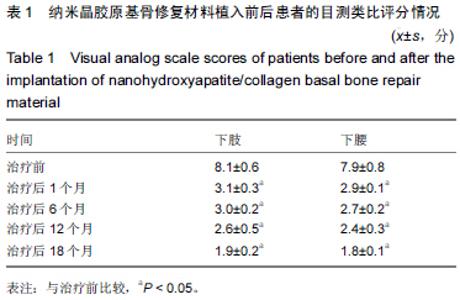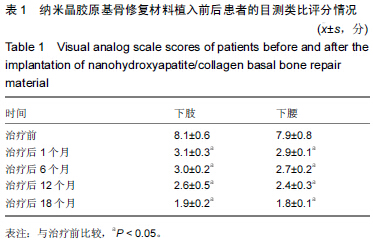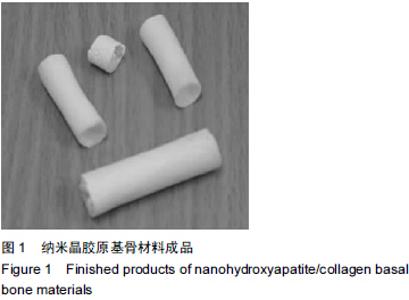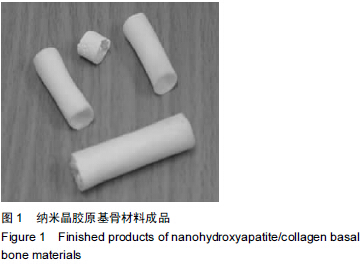[1] 王焱.纳米晶胶原基骨和羟基碱石灰在牙槽嵴骨量不足治疗中的应用[J].中国基层医药,2013,20(15):2326-2328.
[2] 吴广新,汪建国,杜晓岩.纳米晶胶原基骨复合骨髓单个核细胞修复下颌骨缺损[J].中国组织工程研究,2013,17(38): 6791-6796.
[3] 田琴,周凤勤.重组人骨形态发生蛋白-2结合纳米晶胶原基骨材料植骨融合术治疗腰椎不稳症的护理[J].生物骨科材料与临床研究,2013,12(1):64-65.
[4] 徐晓峰,陈静家,狄东华,等.骨形态发生蛋白-聚乙烯砒洛啉酮-纳米晶胶原基骨缓释系统与骨髓间充质干细胞的生物相容性[J].中国组织工程研究,2012,16(51):9563-9566.
[5] 田祖斌,马小东.纳米晶胶原基骨与自体骨颗粒修复糖尿病节段性骨缺损临床观察[J].中国中医骨伤科杂志,2012,20(6):64-65.
[6] 鲁宏.重组人骨形态发生蛋白-2结合纳米晶胶原基骨材料在跟骨骨折治疗中的应用[J].临床急诊杂志,2012,13(4):247-248.
[7] 甄敏钢,侯辰光.重组人骨形态发生蛋白-2结合纳米晶胶原基骨材料植骨融合在腰椎不稳症中的临床应用[J].石油和化工设备, 2011,14(10):20-21.
[8] 鲁宏,廉凯,晏雄伟.重组人骨形态发生蛋白-2结合纳米晶胶原基骨材料植骨融合在腰椎不稳症中的临床应用[J].生物骨科材料与临床研究,2011,8(5):20-22.
[9] 徐成振,杨文贵,何晓峰,等.血管内皮生长因子与纳米晶胶原基骨支架复合修复大鼠股骨缺损[J].中国组织工程研究与临床康复, 2011,15(38):7118-7122.
[10] 穆晓红,赵子义,徐林,等.骨髓间充质干细胞在纳米晶胶原基骨内生长以及成骨潜能[J].中国组织工程研究与临床康复,2011, 15(3): 391-394.
[11] 穆晓红,赵子义,徐林,等.纳米材料支架与骨髓间充质干细胞构建纳米骨修复兔股骨头坏死[J].中国组织工程研究与临床康复, 2010,14(51):9582-9586.
[12] 徐晓峰,刘小平,陈静家,等.纳米晶胶原基骨/血管内皮生长因子缓释支架对人骨髓间充质干细胞体外粘附增殖的影响[J].中国生物医学工程学报,2010,29(5):740-746.
[13] 徐晓峰,刘小平,王明伟,等.血管内皮生长因子/纳米晶胶原基骨缓释系统与人骨髓间充质干细胞的体外生物相容性[J].中国组织工程研究与临床康复,2010,14(25):4636-4640.
[14] 李大鹏,沈铁城,黄永辉,等.纳米晶胶原基骨修复材料与兔骨髓间充质干细胞体外复合培养[J].中国组织工程研究与临床康复, 2009,13(25):4973-4976.
[15] 史坚强,孙广友,马鹏,等.骨髓间充质干细胞复合音猬因子/纳米晶胶原基骨修复骨缺损[J].江苏大学学报:医学版,2009,19(3): 206-209.
[16] 徐晓峰,马鹏,钱栋,等.骨髓间充质干细胞与不同基质修饰的纳米晶胶原基骨体外生物相容性研究[J].中国生物医学工程学报, 2008,27(6):894-899.
[17] 孙伟,李子荣,史振才,等.纳米晶胶原基骨加自体骨移植治疗早期股骨头坏死的临床疗效分析[J].中国修复重建外科杂志,2008, 22(10):1153-1156.
[18] 彭加友,栗国梁,史德刚,等.纳米晶胶原基骨材料在股骨头缺血性坏死FicatⅢ期的初步临床应用[J].中国中西医结合影像学杂志,2008,6(6):415-417.
[19] 黄永辉,夏青,沈铁城,等.人骨髓间充质干细胞接种纳米晶胶原骨构建组织工程骨[J].生物骨科材料与临床研究,2008,5(1):1-3.
[20] 黄永辉,李大鹏,沈铁城,等.同种异体兔骨髓间充质干细胞复合纳米晶胶原基骨修复胫骨缺损的实验研究[J].医学创新研究,2008, 5(2):1-3.
[21] [21]Silva P,Rosa RC,Placo JP,et al.Parafusos automacheantes: comparação mecânica no modelo artificial de osso e na vértebra cervical de carneiro. Self-tapping screws: mechanical analysis in the model of artificial bone and in the cervical sheep vertebra.Tornillos autoterrajante: comparación mecánica en el modelo artificial.Coluna Columna. 2009;8(3).
[22] 夏青,沈铁城,黄永辉,等.应用纳米晶胶原基骨体外构建组织工程骨[J].中国组织工程研究与临床康复,2007,11(23):4492-4495.
[23] “瑞福”纳米晶胶原基骨修复材料[J].中国组织工程研究与临床康复,2007,11(9):1718-1718.
[24] Silva P,Rosa RC,Shimano AC.Macheamento do orifício piloto: análise mecânica na vértebra de carneiro e no modelo de osso artificial.Tapping pilot hole: mechanical analysis of sheep vertebra and the artificial bone model.Rev Bras Ortop. 2010;45(3):290-294.
[25] 孙伟,李子荣,张岚,等.纳米晶胶原基骨与骨髓间充质干细胞复合培养对表型影响[J].中国误诊学杂志,2006,6(8):1419-1421.
[26] 沈铁城,黄永辉,徐晓峰,等.纳米晶胶原基骨材料在临床上的应用[J].医学研究杂志,2006,35(4):70-73.
[27] 襄楠.前沿科技的结晶骨病患者的福音—纳米晶胶原基骨材料临床实验获得成功[J].科技信息,2005,22(12):12-13.
[28] 孙伟,李子荣,史振才,等.纳米晶胶原基骨和骨髓间充质干细胞复合修复兔股骨头坏死缺损的研究[J].中国修复重建外科杂志, 2005,19(9):703-706.
[29] 俞兴,徐林,毕连涌.应用纳米晶胶原基骨材料行腰椎后外侧融合初步效果分析[J].中国矫形外科杂志,2005,13(8):586-588.
[30] 襄楠.前沿科技的结晶骨病患者的福音——纳米晶胶原基骨材料临床实验获得成功[J].科技信息,2005,22(12):12-13.
[31] 俞兴,徐林,毕连涌.纳米晶胶原基骨材料在腰椎后外侧植骨融合中的临床应用[J].生物骨科材料与临床研究,2004,1(7):6-9.
[32] Pfeiffer FM, Choma TJ, Kueny R.Finite element analysis of Stryker Xia pedicle screw in artificial bone samples with and without supplemental cement augmentation.Comput Methods Biomech Biomed Engin.2015;18(13):1459-1467.
[33] Barbe AG,Spennes J,Follmann A,et al.[Periprosthetic bone cement allocation at the femoral durom hip prosthesis. a pilot study: artificial bone models versus ex-vivo femura].Z Orthop Unfall. 2010;148(4):429-435.
[34] Jang DW,Franco RA,Sarkar SK,et al.Fabrication of porous hydroxyapatite scaffolds as artificial bone preform and its biocompatibility evaluation.ASAIO J. 2014;60(2):216-223.
[35] 李大鹏,沈铁城,黄永辉,等.兔骨髓间充质干细胞与纳米晶胶原基骨修复材料体外构建组织工程骨的实验研究[J].江苏大学学报:医学版,2007,17(5):389-392.
[36] 沈铁城,夏青,黄永辉.纳米晶胶原基骨材料在骨科疾病中的应用[J].中国组织工程研究与临床康复,2007,11(1):48-51.



